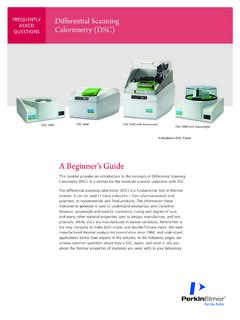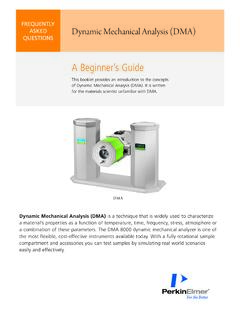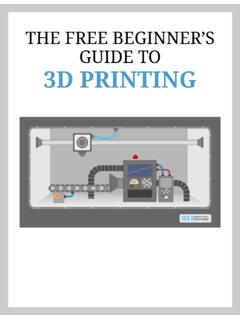Transcription of BEGINNER’S GUIDE TO 3D PRINTING
1 2015 beginner S GUIDE TO 3D PRINTING VERSION THINK3D TEAM Welcome to think3D s beginner s GUIDE to 3D PRINTING . This document is for people who are completely new to 3D PRINTING technology or who are looking at gaining additional information on 3D PRINTING technology. It is very imperative that 3D PRINTING technology is going to change the world. Experts claim 3D PRINTING is a much bigger revolution than internet. We at think3D, completely agree to those viewpoints. In this document, we shall be providing data to illustrate the true revolutionary nature of 3D PRINTING . This document is structured into 6 chapters, (a) Introduction of 3D PRINTING (b) History of 3D PRINTING (c) 3D PRINTING Technology (d) 3D PRINTING Processes (e) 3D PRINTING Materials (f) 3D PRINTING Applications (g) 3D PRINTING Glossary.
2 3D PRINTING is an umbrella term for a host of processes and technologies that offer a full spectrum of capabilities for the production of parts and products in different materials. One thing common in all these processes is the manner in which production is carried out layer by layer in an additive process. That is why 3D PRINTING is also called additive manufacturing in contrast to traditional methods of production that are primarily subtractive in nature, also called as subtractive manufacturing or molding/casting processes. Applications of 3D PRINTING are emerging almost by the day, and, as this technology continues to penetrate more widely and deeply across industrial, maker and consumer sectors, this is only set to increase. Most reputable commentators on this technology sector agree that, as of today, we are only just beginning to see the true potential of 3D PRINTING .
3 About think3D: think3D is India s largest 3D PRINTING platform covering all aspects of 3D PRINTING technology like Latest News , 3D Printers , Print On Demand Services , 3D Design Store & 3D Scanning Services . This document is an attempt to provide the readers a reliable authentic information on various terms and terminologies involved in 3D PRINTING , its history, application areas and benefits. If you wish to contact us and gain more information on 3D PRINTING technology, you can always reach us at 040-3091 1007 or email us at 1 CHAPTER 01 What is 3D PRINTING ? 2 In the 20th century, no other invention affected the mankind more than technology did. With the advent of computers in 1950s and internet in 1990s, the fundamental way of doing things has through a massive changes.
4 These technologies made our lives better, opened up new avenues and possibilities and gave us a hope for the future. But it generally decades for an ecosystem to be built across a particular technology to take it to masses and achieve the truly disruptive nature of that technology. It is widely believed that 3D PRINTING or additive manufacturing (AM) has the vast potential to become one of these technologies. There is a lot of coverage on 3D PRINTING across many television channels, newspapers and online resources. What really is this 3D PRINTING that some have claimed will put an end to traditional manufacturing as we know it, revolutionize design and impose geopolitical, economic, social, demographic and environmental and security implications to our everyday lives? The most basic, differentiating principle behind 3D PRINTING technology is that it is an additive manufacturing process.
5 And this is indeed the key because 3D PRINTING is a radically different manufacturing method based on advanced technology that builds up parts, additively, in layers at the sub mm scale. This is fundamentally different from any other existing traditional manufacturing techniques. Traditional manufacturing process has evolved a lot over time from hand based manufacturing to the automated processes such as machining, casting, forming and molding. Yet these technologies all demand subtracting material from a larger block whether to achieve the end product itself or to produce a tool for casting or molding processes and this is a serious limitation within the overall manufacturing process. For many applications traditional design and production processes impose a number of unacceptable constraints, including the expensive tooling, fixtures and the need for assembly for complex parts.
6 In addition, the subtractive manufacturing processes, such as machining can result in up to 90% of the original block of material being wasted. In contrast, 3D PRINTING process can create objects directly by adding material layer by layer in a variety of ways, depending on the technology used. Simplifying the ideology behind 3D PRINTING , for anyone that is still trying to understand the concept, it could be likened to the process of building something with Lego blocks automatically. 3 3D PRINTING is an enabling technology that encourages and drives innovation with unprecedented design freedom while being a tool-less process that reduces prohibitive costs and lead times. Components can be designed specifically to avoid assembly requirements with intricate geometry and complex features created at no extra cost.
7 3D PRINTING is also emerging as an energy efficient technology that can provide environmental efficiencies in terms of both the manufacturing process itself, utilizing up to 90% of standard materials and throughout the product s operating life through lighter and stronger design. In recent years, 3D PRINTING has gone beyond being an industrial prototyping and manufacturing process as the technology has become more accessible to small companies and even individuals. Previously, only big corporates used to own 3D printers as the scale and economics of owning 3D printer make it prohibitive for smaller companies to own one. But with the rapid decline of the printer cost, the technology has become more affordable. Now a days, smaller and less capable 3D printers can be acquired for under $1000.
8 This has opened up the technology to a much wider audience, and as the exponential adoption rate continues apace on all fronts, more and more systems, materials, applications, services and ancillaries are emerging. 4 CHAPTER 02 History of 3D PRINTING 5 The earliest 3D PRINTING technologies first became visible in the late 1980 s, at which time they were called Rapid Prototyping (RP) technologies. This is because the processes were originally conceived as a fast and more cost-effective method for creating prototypes for product development within industry. As an interesting side note, the first patent application for RP technology was filed by Dr. Kodama in Japan in May 1980. But the full patent specification was not filed before the one year deadline after the application thus voiding the patent application.
9 The first patent for 3D PRINTING technology was issued in 1986 to Mr. Charles Hull for stereolithography apparatus (SLA). He invented the machine in 1983 and went on to cofound 3D Systems Corporation one of the largest and most prolific organizations operating in the 3D PRINTING sector today. 3D Systems first commercial RP system, the SLA-1, was introduced in 1987. As with every new technology, there were lot of researchers working on various ways to attain additive manufacturing in 1980s. In 1987, Mr. Carl Deckard, who was working at the University of Texas, filed a patent in the US for the Selective Laser Sintering (SLS) RP process. This patent was issued in 1989 and SLS was later licensed to DTM Inc, which was later acquired by 3D Systems. In 1989, one Mr. Scott Crump also filed a patent for Fused Deposition Modeling (FDM).
10 He went to co-found another major 3D PRINTING company called Stratasys Inc. As of 2015, FDM has become the most popular 3D PRINTING technology for entry level machines. This technology is based on open source RepRap model. The FDM patent was issued to Stratasys in 1992. In Europe, 1989 also saw the formation of EOS GmbH in Germany, founded by Hans Langer. After a dalliance with SL processes, EOS R&D focus was placed heavily on the laser sintering (LS) process, which has continued to go from strength to strength. Today, the EOS systems are recognized around the world for their quality output for industrial prototyping and production applications of 3D PRINTING . EOS sold its first Stereos system in 1990. The company s direct metal laser sintering (DMLS) process resulted from an initial project with a division of Electrolux Finland, which was later acquired by EOS.






